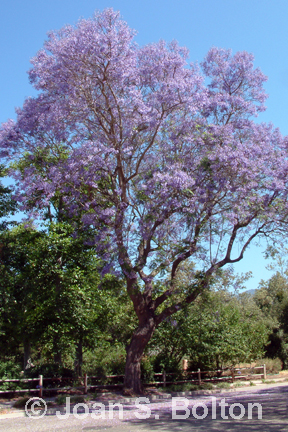
Come summer, spending time with a shady character can be a desirable thing.
Indeed, a living, breathing canopy of green provides a refreshing counterpoint to blazing summer heat.
And shade trees offer the perfect place to cool down for a few minutes, or while away an entire afternoon. Whether you’re into picnicking, reading, lounging or just catching your breath, there’s sure to be a spot in your garden for a shade tree to supply welcome relief.
Big Park Trees
If you have room, a single large tree — or better yet, a group of large trees — can make your back yard feel just like a park.
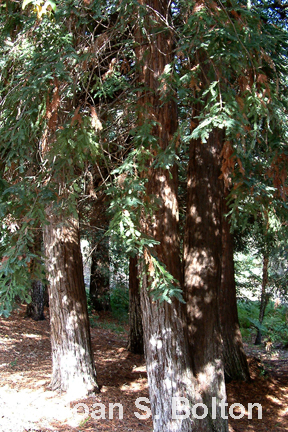
Two of our most massive native trees, coast live oak (Quercus agrifolia) and redwood (Sequoia sempervirens), are both evergreen. Coast live oaks are fully in sync with our natural cycle of wet, cool winters and dry, warm summers. After their first year in the ground, they need no more irrigation. In fact, they are susceptible to a fungus that can run rampant in warm, moist soil, so don’t plant anything beneath their canopies that needs summer irrigation, either.
Coast live oaks grow fast in their early years. In my garden, one that I planted 15 years ago from a 5-gallon container is 35 feet tall, 40 feet wide and has a trunk that’s more than 2 feet wide. It’s slowing down now, but at maturity, it should reach 50 to 70 feet tall and spread at least that wide, or wider.
Redwoods grow fast, too. But unlike coast live oaks, they are thirsty, and do best with irrigation year-round. Next to a lawn, with a constant supply of water, they may grow 3 to 5 feet a year. They will top out at 50 to 90 feet, and 15 to 30 feet wide. If you’d like to create your own grove, space the trees at least 8 to 10 feet apart. Plant them at least that distance from any fences or walls as well. Their graceful branches look terrible squished against an obstacle, and shearing off half a side isn’t much of an option.
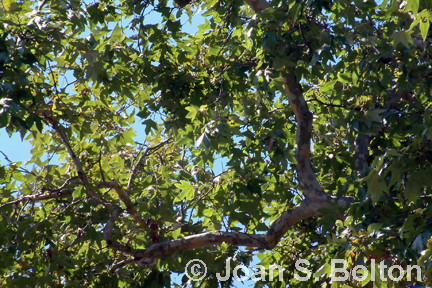
Our native western sycamore trees take on giant proportions, too. In nature, they typically line streams. But on the Central Coast, they grow well anywhere in the garden, and will flourish on rain alone, with their roots traveling underground to tap into whatever moisture may be nearby. They grow several feet a year, reaching 30 to 80 feet tall and 20 to 50 feet wide.
Tall Flowering Shade Trees
While our three big native trees provide lush, leafy shade canopies, a number of large, spreading trees offer beautiful flowers.
Southern magnolias (Magnolia grandiflora) are every bit as statuesque as our natives, plus bear fragrant, creamy white, flat flowers as large as dinner plates on top of large, glossy, evergreen leaves. Those leaves form a dense block against the sun, casting deep shade below. The trees also have shallow surface roots, making it difficult to grow anything directly beneath them.
Southern magnolias grow relatively slowly to 80 feet tall and 60 feet wide. They are at their best with deep watering, good drainage and fertile soil.
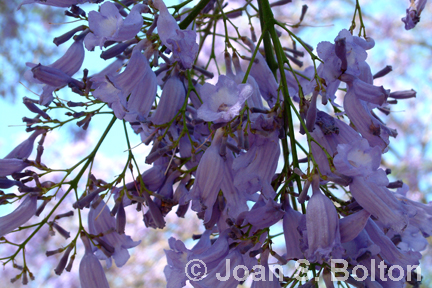
For a more fluttery shade, consider planting a jacaranda (Jacaranda mimosifolia) or a silk or mimosa tree (Albizia julibrissin). Both have similar silhouettes; they are single-trunk or multi-trunk trees; they are deciduous; and they grow at a medium pace to 25 to 40 feet tall, and up to twice as wide. Their beefy trunks and muscular branches bear surprisingly delicate, lacey leaves and striking flowers.
Jacarandas bloom in purple, with clusters of bell-shaped flowers that dangle from gnarled branches. Silk trees bear powder-puff clusters of salmon-colored, thready flowers on top of the leaves. Plant yours on a lower hillside or beneath a two-story window, where you can look down to admire the flowers.
Jacarandas do best with good drainage: sandy soil with moderate moisture is optimal. However, even with good drainage, don’t plant yours next to a lawn or anywhere else with frequent, shallow watering.
Silk trees, on the other hand, will tolerate a several-day-a-week, lawn-watering regimen. Just make sure that your sprinklers don’t douse their trunks.
Marina strawberry trees (Arbutus ‘Marina’) provide a nice, filtered swath of shade. They are also one for the birds, which love to feast on their round, red fruit. The trees present a rugged appearance, with stout trunks covered in rough, red bark that bubbles out and away, exposing glossy, cinnamon-colored new bark beneath. Meanwhile, clusters of small, dark pink, urn-shaped flowers bloom most of the year. The growth is slow but steady, with the trees reaching 25 to 40 feet tall and 20 to 30 feet wide on just a few cycles of deep watering during summertime.
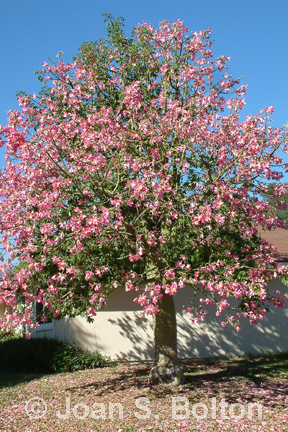
Floss silk trees (Chorisia speciosa) have even broader trunks.
More stunning, still, are the hundreds of stubby, miniature volcano-like spines that cover those trunks, much like armor on some sort of prehistoric creature.
Their branching is open, providing dappled shade. They bear big, pink, orchid-like flowers just before Thanksgiving, at which point their leaves begin to drop for winter.
Floss silk trees grow fast at the outset, climbing 3 to 5 feet a year. They eventually top out at 30 to 60 feet tall and wide. They do best with a deep soak once a month and good drainage.
Shorter Shade Trees (Say that 10 times fast!)
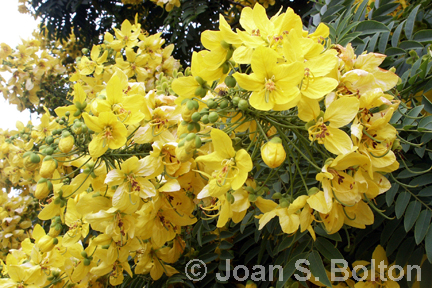
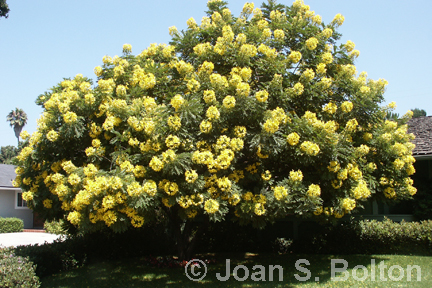
Gold medallion trees (Cassia leptophylla) are the mop-tops of shade trees, forming tall, broad domes of tightly packed leaves that cast dense shade on the ground below. Balls of bright yellow flowers appear in summer, then bloom into fall.
These trees grow fast, quickly reaching 20 to 25 feet tall and 30 feet wide. The branches tend to sag over time: you’ll need to trim the branches occasionally or end up ducking to take advantage of the shade beneath.
Gold medallions adapt to a wide variety of conditions, and tolerate different soils and occasional to regular watering.
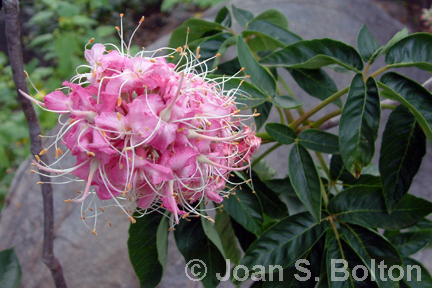
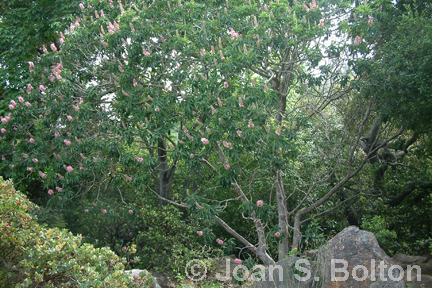
Canyon Pink California buckeyes (Aesculus californica ‘Canyon Pink’) are native trees introduced by the Santa Barbara Botanic Garden. Often multi-trunked, with spreading, open branches, they grow fast to 15 to 40 feet tall and wide, and offer light shade.
Fragrant, pink flowers bloom in spring and attract hummingbirds and butterflies. Their native habitat ranges from oak woodlands to chaparral. They grow well in a wide variety of soils with everything from drought to regular summer water.
≈
Beware of Power Lines
Before planting a large shade tree — or any tree, for that matter — be sure to look up for utility poles and power lines. PG&E recommends planting trees no taller than 25 feet within 20 feet of power lines, and none taller than 40 feet within 30 feet of power lines.
PG&E also offers “A Guide to Small Trees Near Distribution Lines.” To request a copy, call 800-743-5000, or send an e-mail to RightTreeRightPlace@pge.com, and specify that you’d like to receive the guide for Central California.
≈
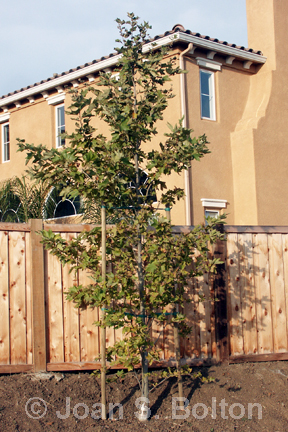
Seeds of Wisdom
Plant large shade trees at least 5 feet from your house, fence, driveway, sidewalk or street.
When in doubt as to whether surface roots will create a problem, install a root barrier to force the roots to grow down several feet before spreading into the adjacent soil.
≈
Copyright, Joan S. Bolton. All rights reserved. Reproduction of text or photos in any form is prohibited without written permission.
≈
